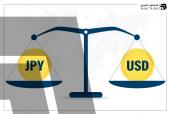US Dollar Attempts Recovery Amid Rising Bond Yields and Euro Weakness

The US dollar is striving to rebound from the significant losses recorded in the previous session, with the dollar index edging up by 0.17% to settle at 106.19 points during Thursday's trading. This modest recovery comes amid a lack of impactful US economic data, while support for the dollar stems from rising US bond yields and weakness in the euro driven by economic developments in the Eurozone.
Rising US Bond Yields Bolster Dollar Strength
The increase in US bond yields across various maturities has provided a strong tailwind for the dollar. The 10-year Treasury yield climbed by 0.21% to 4.253%, while the 20-year yield surged by 0.33% to 4.530%. Additionally, the yield on 30-year bonds gained 0.25%, reaching 4.439%. These rises have made the US dollar a more attractive investment, prompting increased demand and contributing to its stronger performance in global markets.
Euro Declines, Supporting Dollar Gains
The euro faced downward pressure following the release of disappointing German inflation data, which showed a contraction of 0.2% on a monthly basis for November. This fueled market expectations that the European Central Bank will continue to lower interest rates in response to subdued inflation and sluggish economic growth. The euro/dollar pair fell by 0.12% during today's trading, amplifying the dollar's recovery.
Rate Cut Expectations Weigh on Dollar Performance
Despite the tailwinds from bond yields and euro weakness, the dollar's gains have been tempered by growing market expectations of a Federal Reserve rate cut. The probability of a 25-basis-point reduction at the Fed's next meeting has risen to 70%, while the likelihood of holding rates steady has dropped to 30%. These expectations have exerted downward pressure on the dollar, limiting the extent of its rebound.
Looking Ahead: Key Influences on the Dollar
In the absence of major US economic data releases, investors are closely watching for any comments from Federal Reserve officials or new data that could provide fresh direction for the dollar. For now, the currency's movements remain influenced by the interplay of rising bond yields and shifting monetary policy expectations.
Read also:
Dollar Drops Gains and Awaits the Fed's Preferred Inflation Data!









